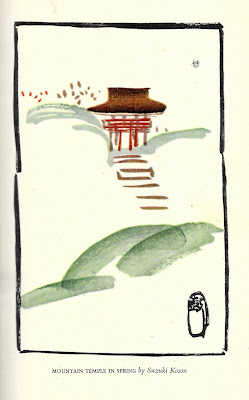Although haiku was known among
avant-garde circles in the West prior to World War II, the literary form did
not become familiar to a wider English-speaking audience until the late 1950s
and early 1960s. To a large degree, the
publication of two anthologies introduced haiku to the reading citizenry: Harold G. Henderson’s An Introduction to
Haiku in 1958, and Harold Stewart’s A Net of Fireflies in 1960.
Of the two, Henderson’s work is probably better remembered today and more widely available. Without taking anything away from Introduction’s continuing value through the decades, Fireflies deserves renewed attention.
There is nothing: there is everything. [1]
Whose thoughtless hand has broken off their limb.
--Chiyo-ni
Every flower I touch—a hidden thorn.
--Issa
Like goldfish undulating fins and tail.
--Getto
IRONICAL
How hot the pedlar, panting with his pack
Of fans—A load of breezes on his back!
--Kakô
How hot the pedlar, panting with his pack
Of fans—A load of breezes on his back!
--Kakô
The net is now, with no one at my side!
--Ukihashi
Has slashed, recedes the wild night-heron’s shriek.
--Bashô
My wild umbrella drives me back again.
--Shisei
Would be a streak of snow across the sky.
--Sôkan [3]
Mountain Temple in
Spring by Suzuki Koson
Autumn in a
Mountain Village by Ishikawa Kinichirô
Wintry Grove Under
a Waning Moon by Suzuki Rimpû [7]
A wide-ranging essay on the
essence of haiku occupies about a third of the book’s 150 pages of text on folded
leaves. Stewart expects a lot from the
writer of haiku, and his advice is as valuable today as it was in 1960. “The spontaneous conception and impromptu
expression required for a successful haiku are…a supreme test of poetic
concentration, conciseness and clarity.
The eye must always be on the object: the poet nowhere to be seen.” [8]
For its historical perspective as well as its continued relevance, A Net of Fireflies deserves a place on anyone’s haiku bookshelf. It is well worth the modest effort and cost to obtain a copy from the second-hand market. Ignore any paperback reprint; find a first-edition version, one with the green box cover as shown at the top of this article. The purchaser will not be disappointed.
[1] Stewart, Harold, A Net of Fireflies: Japanese Haiku and Haiku Paintings, Tokyo, Charles E. Tuttle Company, 1960, 13
[2] The Los Angeles Times, January 10, 1961, III-5
[3] Stewart, Fireflies: More than Forgiven, 14; Return of the Dispossessed, 30; Dancers of Old Kyoto, 45; Ironical, 55; After the Death of Her Lover, 72; Double-Edged, 78; Contrary-Willed, 96; The Voice of Snow, 104
[4] The Indianapolis News, February 11, 1961, 2
[5] The San Francisco Examiner, February 12, Highlight, 7
[6] The Sacramento Bee, January 8, 1961, L14
[7] Stewart, Fireflies: Mountain Temple, 21; River Breeze, 42; Autumn in a Mountain Village, 67; Wintry Grove, 100. Artwork in the public domain.
[8] Ibid, 123—124
For its historical perspective as well as its continued relevance, A Net of Fireflies deserves a place on anyone’s haiku bookshelf. It is well worth the modest effort and cost to obtain a copy from the second-hand market. Ignore any paperback reprint; find a first-edition version, one with the green box cover as shown at the top of this article. The purchaser will not be disappointed.
[1] Stewart, Harold, A Net of Fireflies: Japanese Haiku and Haiku Paintings, Tokyo, Charles E. Tuttle Company, 1960, 13
[2] The Los Angeles Times, January 10, 1961, III-5
[3] Stewart, Fireflies: More than Forgiven, 14; Return of the Dispossessed, 30; Dancers of Old Kyoto, 45; Ironical, 55; After the Death of Her Lover, 72; Double-Edged, 78; Contrary-Willed, 96; The Voice of Snow, 104
[4] The Indianapolis News, February 11, 1961, 2
[5] The San Francisco Examiner, February 12, Highlight, 7
[6] The Sacramento Bee, January 8, 1961, L14
[7] Stewart, Fireflies: Mountain Temple, 21; River Breeze, 42; Autumn in a Mountain Village, 67; Wintry Grove, 100. Artwork in the public domain.
[8] Ibid, 123—124
Russell Streur
A version of this article was originally published in Seashores, Volume 10, April 2023.
















No comments:
Post a Comment